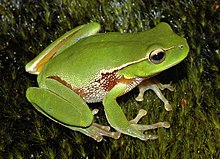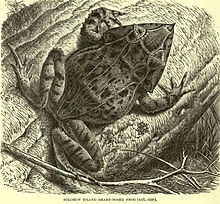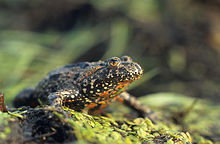Portal:Amphibians
The Amphibian Portal
Amphibians are ectothermic, anamniotic, four-limbed vertebrate animals that constitute the class Amphibia. In its broadest sense, it is a paraphyletic group encompassing all tetrapods, excluding the amniotes (tetrapods with an amniotic membrane, such as modern reptiles, birds, and mammals). All extant (living) amphibians belong to the monophyletic subclass Lissamphibia, with three living orders: Anura (frogs), Urodela (salamanders), and Gymnophiona (caecilians). Evolved to be mostly semiaquatic, amphibians have adapted to inhabit a wide variety of habitats, with most species living in freshwater, wetland or terrestrial ecosystems (such as riparian woodland, fossorial and even arboreal habitats). Their life cycle typically starts out as aquatic larvae with gills known as tadpoles, but some species have developed behavioural adaptations to bypass this.
The young generally undergo metamorphosis from larva with gills to an adult air-breathing form with lungs. Amphibians use their skin as a secondary respiratory surface and some small terrestrial salamanders and frogs lack lungs and rely entirely on their skin. They are superficially similar to reptiles like lizards, but unlike reptiles and other amniotes, require water bodies in which to breed. With their complex reproductive needs and permeable skins, amphibians are often ecological indicators; in recent decades there has been a dramatic decline in amphibian populations for many species around the globe.
The earliest amphibians evolved in the Devonian period from sarcopterygian fish with lungs and bony-limbed fins, features that were helpful in adapting to dry land. They diversified and became ecologically dominant during the Carboniferous and Permian periods, but were later displaced in terrestrial environments by early reptiles and basal synapsids (mammal predecessors). The origin of modern amphibians belonging to Lissamphibia, which first appeared during the Early Triassic, around 250 million years ago, has long been contentious. However the emerging consensus is that they likely originated from temnospondyls, the most diverse group of prehistoric amphibians, during the Permian period. (Full article...)
Selected frog article
Selected salamander article
List of selected salamander articles
|
|---|
Did you know? –

- ... that the bird-voiced treefrog and the pine woods treefrog can be recognised by their distinctive calls?
- ... that the Pyrenean frog breeds in mountain streams after the snow has melted?
- ... that the call of the male river frog (pictured) can be described as a "deep, low-pitched, rolling snore"?
Selected amphibian type
Toad is a common name for certain frogs, especially of the family Bufonidae, that are characterized by dry, leathery skin, short legs, and large bumps covering the parotoid glands.
A distinction between frogs and toads is not made in scientific taxonomy, but is common in popular culture (folk taxonomy), in which toads are associated with drier, rougher skin and more terrestrial habitats. (Full article...)List of selected amphibian type articles
|
|---|
Selected images
Selected toad article

The Korean water toad, Korean toad, water toad, or Stejneger's toad (Bufo stejnegeri), is a species of toad found in East Asia. Two distinct populations are known to exist, one in eastern Liaoning province of northeastern China, and one in the central mountains of the Korean Peninsula. Within South Korea, it is found in eastern Gyeonggi (specifically Gapyeong) and also in Gangwon-do (particularly the Odaesan mountain complex). In addition, it is expected that there are or have been additional populations in the region between central Korea and Liaoning.
The classification of the Korean water toad into the genus Bufo was challenged in a 2006 paper. However, no alternative classification was proposed and the species is at present provisionally allocated to Bufo.
The Korean water toad is found inland, at elevations from 200 to 700 meters above sea level. As its name suggests, it favors water, and is typically found in wooded riparian areas. Breeding and egg-laying take place in the waters of streams and rivers. The water toad is typically nocturnal, but is also active during the day during the summer rains. (Full article...)Selected caecilian article

Need help?
Do you have a question about Amphibians that you can't find the answer to?
Consider asking it at the Wikipedia reference desk.
Topics
Subcategories
Related portals
Associated Wikimedia
The following Wikimedia Foundation sister projects provide more on this subject:
-
Commons
Free media repository -
Wikibooks
Free textbooks and manuals -
Wikidata
Free knowledge base -
Wikinews
Free-content news -
Wikiquote
Collection of quotations -
Wikisource
Free-content library -
Wikiversity
Free learning tools -
Wiktionary
Dictionary and thesaurus










































